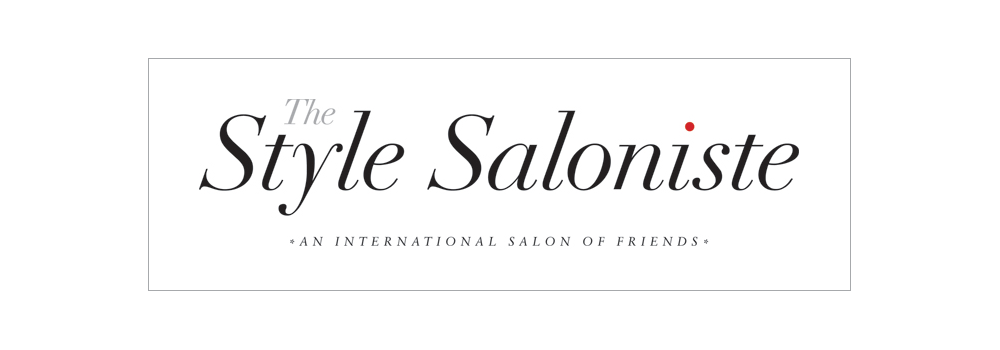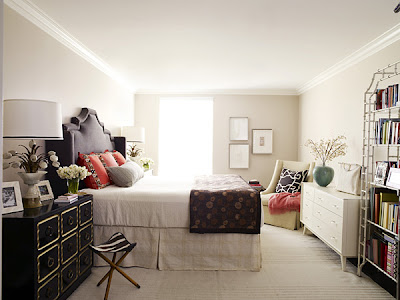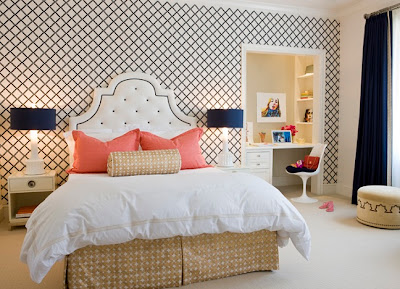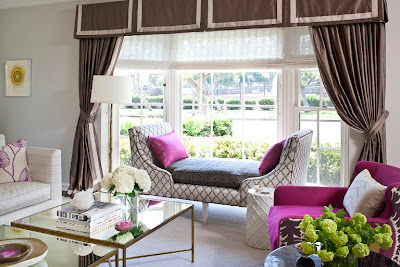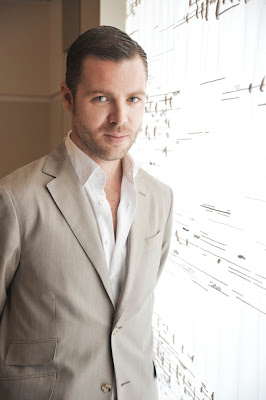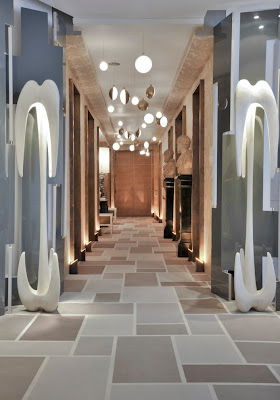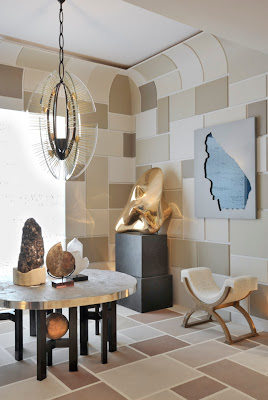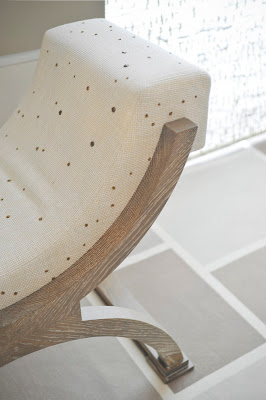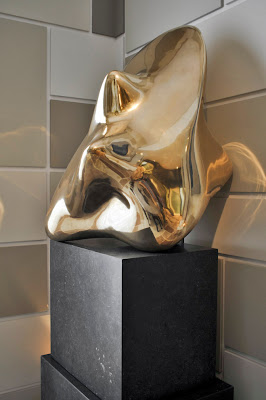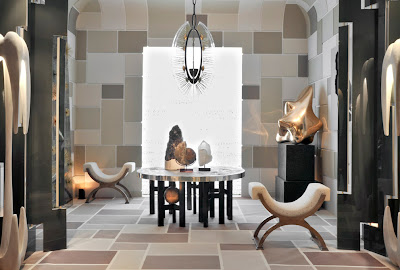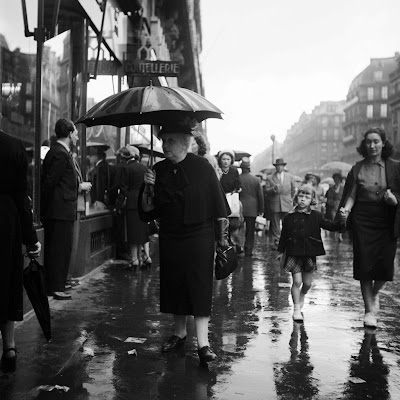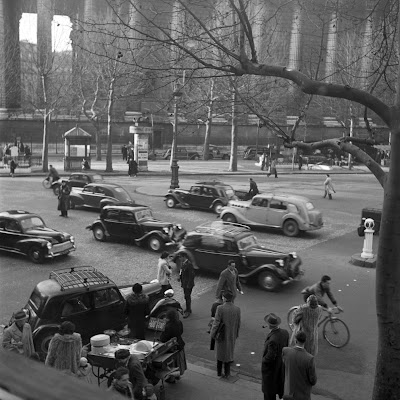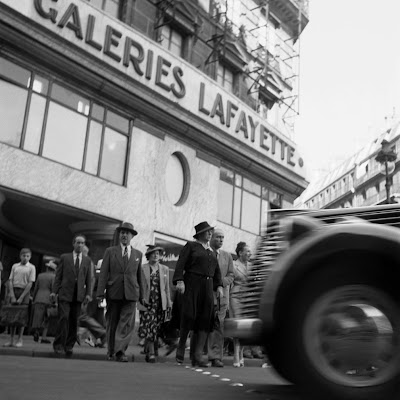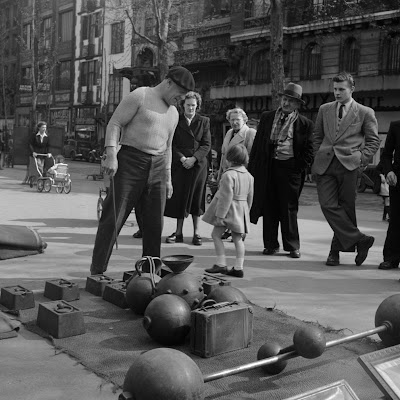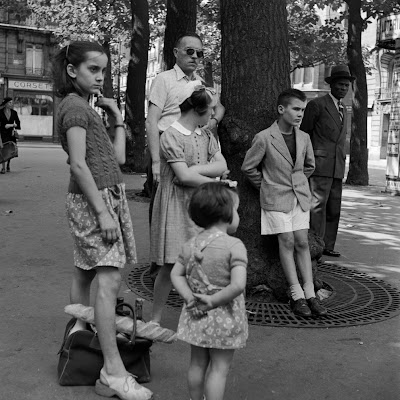 |
| Melissa Warner, left, and company co-founder Julie Massucco Kleiner. |
Julie Massucco and Melissa Warner made their debut with the vivid Guest Bedroom at the 2008 San Francisco Decorator Showcase. With their partner, Carrie Miller, they started Massucco Warner Miller Interior Design and Decoration in 2008.
Join us for my interview with Julie Massucco Kleiner and Melissa Warner
Julie Massucco Kleiner
Since then, the engaging and hard-working designers have made a big splash—with interiors featured on the cover of House Beautiful, and clients around the country.
I admire the freshness of their work. Their interiors look modern and contemporary—but the rooms are anchored in a sense of tradition, grace, comfort and lightness.
There’s no pretension in the work. Best of all, they’re not pushing a ‘California’ look.
I admire the freshness of their work. Their interiors look modern and contemporary—but the rooms are anchored in a sense of tradition, grace, comfort and lightness.
There’s no pretension in the work. Best of all, they’re not pushing a ‘California’ look.
And this design firm has avoided having a ‘signature’ style. Each project has its own logic, approach, personality, color choices, and textures.
Come and meet Julie and Melissa, and see beautiful images of their new work.
“We try to create rooms that strike a balance between being well thought out and detailed, with a mix of color, textures, and furniture styles. Yet they are approachable at the same time, and they always have a pattern that pops. It’s all in the details: We love embellishing upholstery, window treatments, and soft goods with custom details.”—Melissa Warner
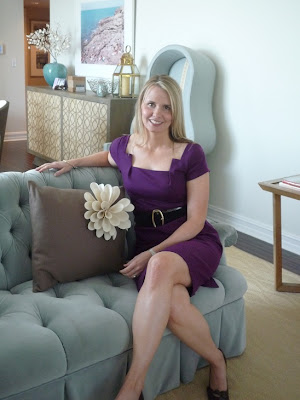 |
| Julie Massucco Kleiner |
Join us for my interview with Julie Massucco Kleiner and Melissa Warner
DDS: Wonderful to see you, Julie and Melissa. Your work is so fresh and client-friendly. I’m impressed with the polish of your work. The rooms always look so happy.
JMK: Thank you! We are fortunate to have past and current clients who appreciate a bright and clean look with lots of details that ensure polish. We tend to attract young couples and families, and so even though we do use lighter colors (and sometimes even white), we have to create homes that are flop-on-sofa livable, since there are kids, dogs.
JMK: Thank you! We are fortunate to have past and current clients who appreciate a bright and clean look with lots of details that ensure polish. We tend to attract young couples and families, and so even though we do use lighter colors (and sometimes even white), we have to create homes that are flop-on-sofa livable, since there are kids, dogs.
Comfort is key for our clients, yet we don’t like to do sloppy and oversized. Tailoring to the size of the house, and finishing details (hemstitching, tape trims on edges, neat Roman shades, etc) keep the look fresh for us and give our rooms personality.
MW: People are always so surprised that children live in most of the houses that we work on because the interiors are so tailored. Luckily, there are many great kid-friendly and durable materials on the market so we’re able to keep our client’s homes comfortable and durable, without sacrificing style. One of our favorite fabrics for a dining area is faux leather, which is very resilient, and completely wipeable for spills—we’d be lost without it.
MW: People are always so surprised that children live in most of the houses that we work on because the interiors are so tailored. Luckily, there are many great kid-friendly and durable materials on the market so we’re able to keep our client’s homes comfortable and durable, without sacrificing style. One of our favorite fabrics for a dining area is faux leather, which is very resilient, and completely wipeable for spills—we’d be lost without it.
DDS: How do you achieve this very fresh and new look—without interiors looking the slightest bit trendy?
MW: We love mixing classic pieces with a hint of the unexpected. Using a base of clean and classic furniture, mixed with a few funkier pieces, makes the room exciting and fresh without being predictable. Pops of color—yellow, orange, acid green, lilac—used in unconventional ways create a lighthearted space. At the beginning of the design process, clients sometimes ask if the house will feel too serious or fancy once it is all done, but we assure them that we always infuse a playful element into each space that makes it inviting and warm.
JMK: It’s that mix of several styles of furniture and/or fabric that keep things lively and unpredictable. We emphasize to our clients that while they may love all the pieces from a certain designer, we never want to use too many from that one source. That would be boring and look dated quickly, and it would also look like the showroom. One thing that keeps our work fresh (especially given the fact that we work in Southern California and Seattle where there is an abundance of mid-century architecture) is to not just let the architecture drive the furnishings, but find a blend of pieces that speak to the scale of the space, the function, the client’s personality, time, location, purpose, goals.
DDS: You’ve been working all over the country, with clients in Miami and Los Angeles, Seattle, San Francisco, all climates and different light. You’ve formulated a professional approach a plan of action, a way of working on design.
JMK: We have a very clear and defined plan of attack and organizational focus. We first walk the site. No matter where it is, it’s crucial for us to see it in person. We take copious notes and snapshots, as well as doing a detailed and perfect site measure. Sometimes we’re lucky enough to have a set of pre-existing plans (which we verify measurements of if the job is going to be long distance), and then we draw furniture layouts, elevations and any other sketches that are helpful to either our team or our client. Next step is a must for us—we do an itemized shopping list—everything from cabinet pulls to the artwork, and sometimes this step involves putting a budget number to each item. This really is a helpful working document for us, and clients love it—no surprises at the end of day with the budget! After the drawings and list are in hand, we shop. We shop locally depending on where the job is. We use our tried and true workrooms we can rely on to create the best quality work. Often it means flying our seamstress to the job. Once the shopping and design items are underway, we have a fabulously organized office manager who keeps our schedules on track until installation. We meet frequently to update and watch every detail.
JMK: We have a very clear and defined plan of attack and organizational focus. We first walk the site. No matter where it is, it’s crucial for us to see it in person. We take copious notes and snapshots, as well as doing a detailed and perfect site measure. Sometimes we’re lucky enough to have a set of pre-existing plans (which we verify measurements of if the job is going to be long distance), and then we draw furniture layouts, elevations and any other sketches that are helpful to either our team or our client. Next step is a must for us—we do an itemized shopping list—everything from cabinet pulls to the artwork, and sometimes this step involves putting a budget number to each item. This really is a helpful working document for us, and clients love it—no surprises at the end of day with the budget! After the drawings and list are in hand, we shop. We shop locally depending on where the job is. We use our tried and true workrooms we can rely on to create the best quality work. Often it means flying our seamstress to the job. Once the shopping and design items are underway, we have a fabulously organized office manager who keeps our schedules on track until installation. We meet frequently to update and watch every detail.
For long-distance installations, we have our kits (everything from a steamer to felt furniture pads, to touch up pens). We source accessories and finishing details locally during the installation.
MW: Clients love the itemized shopping list, and it helps everyone stay on the same page with the budget and general project progress. We think it’s important to look at the big picture first, so we can get an understanding of the entire scope, before diving into the details.
MW: Clients love the itemized shopping list, and it helps everyone stay on the same page with the budget and general project progress. We think it’s important to look at the big picture first, so we can get an understanding of the entire scope, before diving into the details.
DDS: How did your aesthetic develop?
MW: Our hometowns definitely have had an effect on our aesthetic. Julie’s from Vermont and I’m from Los Angeles where the culture is very relaxed and vibrant. I grew up going to Palm Springs for family vacations, and now find myself loving mixing in vintage and mid century pieces into my designs. Now when I go there with my family, I sneak off and hit the vintage stores. It’s become a family event—a couple of Thanksgivings ago, my mom came with me shopping in downtown Palm Springs where I found a pair of Dorothy Draper chests (which I had to buy on the spot!) that I use as my bedside tables. And my dad came with me to the modernism show in Palm Springs to scour the booths for treasures. My parents now have their first vintage piece. It’s a Curtis Jere raindrops mirror I found at a consignment store for a steal when I re-did their bedroom recently.
MW: Our hometowns definitely have had an effect on our aesthetic. Julie’s from Vermont and I’m from Los Angeles where the culture is very relaxed and vibrant. I grew up going to Palm Springs for family vacations, and now find myself loving mixing in vintage and mid century pieces into my designs. Now when I go there with my family, I sneak off and hit the vintage stores. It’s become a family event—a couple of Thanksgivings ago, my mom came with me shopping in downtown Palm Springs where I found a pair of Dorothy Draper chests (which I had to buy on the spot!) that I use as my bedside tables. And my dad came with me to the modernism show in Palm Springs to scour the booths for treasures. My parents now have their first vintage piece. It’s a Curtis Jere raindrops mirror I found at a consignment store for a steal when I re-did their bedroom recently.
JMK: Growing up in New England (Vermont year round and Maine in the summers) definitely had an effect on my aesthetic. I tend toward breezy fabrics. I adore any type of linen—chunky for upholstery, sheer for windows and everything in between. I like to design comfortable interiors that can be sand, grass and bathing suit friendly! Living in Florence while in college nurtured my love of classical architectural and decorative elements—pediments, paneling, molding, gilding that all make appearances on custom furniture and cabinetry and even hardware.
DDS: What’s the first thing you do with a new client?
JMK: It’s essential to really talk to our clients, find out how they live. It’s useful to discuss photos or design blogs that they either like or dislike. Visuals, no matter how few, really can tell a lot about what the client is hoping to achieve. With the clients’ saved magazine pages and product shots and perhaps a design file, we can take the conversation away from the abstract (words like ‘romantic’ can be very ambiguous) and see precisely what the client loves.
JMK: It’s essential to really talk to our clients, find out how they live. It’s useful to discuss photos or design blogs that they either like or dislike. Visuals, no matter how few, really can tell a lot about what the client is hoping to achieve. With the clients’ saved magazine pages and product shots and perhaps a design file, we can take the conversation away from the abstract (words like ‘romantic’ can be very ambiguous) and see precisely what the client loves.
MW: We always tell clients that showing us photos of what they don’t like, helps us as much as images of what they do like. Clients have a particular aversion to a specific color, type of pattern, furnishing style, or textiles, so it’s important for us to know their dislikes as well as their likes.
DDS: How do you get the best information from your clients? Your designs are very custom-crafted.
MW: Design concepts are presented to clients by room, giving them a cohesive and detailed plan of furnishings, fabrics, and window and floor coverings. When we’re buying a piece of furniture from a showroom, we show our clients an image of the piece along with finish samples and/or fabrics. Many of our pieces are custom designed, so our clients have to have faith and trust in us. Often there isn’t a photo of the piece, since we’re designing it and making it from scratch. Sketches and finish/fabric samples paint a picture of the finished product but they still have to use their imagination.
MW: Design concepts are presented to clients by room, giving them a cohesive and detailed plan of furnishings, fabrics, and window and floor coverings. When we’re buying a piece of furniture from a showroom, we show our clients an image of the piece along with finish samples and/or fabrics. Many of our pieces are custom designed, so our clients have to have faith and trust in us. Often there isn’t a photo of the piece, since we’re designing it and making it from scratch. Sketches and finish/fabric samples paint a picture of the finished product but they still have to use their imagination.
JMK: Some clients prefer to know every last detail and are very detail-oriented, so we ensure that they are seeing things like the pitch of the chair back while it’s being made at our upholsterer. For others, it’s one or two large presentations at the get-go of the job with fabrics, furniture, colors, and window covering styles and then we’re off. Usually there are a few specific areas (master bedrooms are of passionate interest for women, and it’s usually the study for the men) where our client might want to be a little more hands on. If there are vintage pieces or antiques, we take a client on a pre-planned and carefully mapped-out shopping day to find one-of-a -kind pieces. Other clients would rather have their hair pulled out than go scouring the flea market with us!
DDS: You each have more than a decade of experience in the design field—and design degrees—and yet it feels as if you were an overnight sensation. Suddenly you were on the cover of House Beautiful and splashed over twelve pages, and then published in a Brazilian design publication, Traditional Home, San Francisco magazine.
JMK: We definitely put our time in with various firms on jobs around the country. I started at a large New York architectural firm, and learned fundamentals of space planning and organization that have been useful. My residential design career, which followed, is definitely my L-O-V-E. I believe in doing what you love and success will follow.
JMK: We definitely put our time in with various firms on jobs around the country. I started at a large New York architectural firm, and learned fundamentals of space planning and organization that have been useful. My residential design career, which followed, is definitely my L-O-V-E. I believe in doing what you love and success will follow.
We are really so lucky that magazine editors like you have noticed our work, it seemed like one thing led to another after running into you during our first SF Decorator Showcase. Blogs like THE STYLE SALONISTE have been a huge part of getting our name out there. We’ve never advertised. We are amazed at the great publicity. We are often asked for the name of our publicist. We don’t have one.
MW: We feel very lucky that our work has been embraced and noticed. We both have such a passion for interior design and a respect for the design community, and we’re thrilled to be a part of it! Julie and I both worked our way up in the design field starting with internships and eventually more senior design positions at various firms. We’ve had our hands in all aspects/levels of the design process, and I think that this, along with our design education, has made us appreciate all aspects of the design process, and helps us be efficient in working with clients, showrooms, and workrooms.
DDS: You’ve launched MWM A La Carte.
JMK: On our website (see below) we offer customized cameo pillows and some large-scale print pillows that work with our cameos in our signature hues like oranges, turquoises, yellows, tempered by white and of course pale grey. Our designs have our signature details such as grosgrain ribbon flanges. We decided to offer them online, to the general public. There are instructions for taking a great profile shot if you’re ordering a cameo, and we make the pillows the same way we do for clients with luxurious fill and at a nice size-not skimpy.
JMK: On our website (see below) we offer customized cameo pillows and some large-scale print pillows that work with our cameos in our signature hues like oranges, turquoises, yellows, tempered by white and of course pale grey. Our designs have our signature details such as grosgrain ribbon flanges. We decided to offer them online, to the general public. There are instructions for taking a great profile shot if you’re ordering a cameo, and we make the pillows the same way we do for clients with luxurious fill and at a nice size-not skimpy.
We’re dipping our toes into the world of product design. We’ll add ottomans, consoles, chairs. Stay tuned.
DDS: Inspirations?
JMK: Fashion color palettes and details. Interiors and fashion are often in synch with colors, shapes, details, silhouettes, concepts. I just started a job in San Francisco and it’s a completely blank palette. I am gravitating towards “fall” colors—rich, saturated hues of yellow, teal and olive green… feels like fall and is probably linked back to something I saw last time I was clothes shopping!
JMK: Fashion color palettes and details. Interiors and fashion are often in synch with colors, shapes, details, silhouettes, concepts. I just started a job in San Francisco and it’s a completely blank palette. I am gravitating towards “fall” colors—rich, saturated hues of yellow, teal and olive green… feels like fall and is probably linked back to something I saw last time I was clothes shopping!
The number of magazines I get and actually read is astonishing, though I do have a lot of time on airplanes to read them these days. I also look at my old stacks of House Beautiful and Domino magazines. Very inspiring.
MW: I go to the design center or out shopping at showrooms or vintage stores, and my mind starts racing with ideas. Sometimes one small detail or fabric can end up inspiring an entire room or house. Shopping one day I found a gorgeous Suzani fabric from Donghia that ended up inspiring the entire layout and color scheme of a living room I recently completed in Beverly Hills. The pattern and color were striking so oriented the chairs so their backs, which are upholstered in the Suzani, are the first things you see when you walk into the room.
DDS: Favorite designers?
JMK: David Hicks, and also the amazing Mark Hampton. Their work still looks current, and I often use a Hicks-esque pattern (Stark carpet has some of my favorites) or details Mark Hampton would have used. I think of him when I’m using brass things-lamps, cabinet hardware.
JMK: David Hicks, and also the amazing Mark Hampton. Their work still looks current, and I often use a Hicks-esque pattern (Stark carpet has some of my favorites) or details Mark Hampton would have used. I think of him when I’m using brass things-lamps, cabinet hardware.
MW: I love the softness in Suzanne Kasler’s work, and I admire Miles Redd’s bold use of color on walls. One of my all time favorites in Frances Elkins—her work is so understated, balanced, timeless and elegant.
 |
| Melissa Warner |
DDS: What’s next?
MW: We’re starting a number of projects with clients whose first homes we’ve already done, and now we’ll work on a new home, or vacation home. We also just opened a new studio in West Hollywood. We now have a street presence, and we’ve been having a lot of fun decorating the space. We saw this space and we knew it was meant to be because the molding on the walls was in the shape of the cartouche of our logo.
MW: We’re starting a number of projects with clients whose first homes we’ve already done, and now we’ll work on a new home, or vacation home. We also just opened a new studio in West Hollywood. We now have a street presence, and we’ve been having a lot of fun decorating the space. We saw this space and we knew it was meant to be because the molding on the walls was in the shape of the cartouche of our logo.
JMK: We are working on some great jobs all over the West Coast. I am currently trying to start up a Designer Showcase fundraiser house here in Seattle. The city has been without for quite a few years and I am making it my mission to drum up interest.
DDS: Julie and Melissa, I wish you continued success, fabulous clients, and much happiness. Thank you.
“My clients are becoming more open-minded about using unconventional materials in unpredictable ways: a glazed linen coffee table or an upholstered leather side table.”—Julie Massucco
Julie Massucco Kleiner
Julie refined her interior design skills for a decade at several high-end residential and commercial firms in Manhattan and San Francisco before co-founding MWM in 2008. Frequent travel abroad continues to exert a major influence in Julie’s work. Julie is currently working on projects in Seattle, San Francisco and Sun Valley in addition to spending time with her husband and 1-year-old son Ben.
Melissa Warner
While working for two renowned San Francisco design firms she produced numerous high profile residential projects in New York, Miami and San Francisco, before co-founding MWM in 2008. Melissa now resides in Los Angeles, and is currently working on projects in Montecito, Los Angeles, and San Francisco, as well as planning her upcoming wedding.
Credits:
While working for two renowned San Francisco design firms she produced numerous high profile residential projects in New York, Miami and San Francisco, before co-founding MWM in 2008. Melissa now resides in Los Angeles, and is currently working on projects in Montecito, Los Angeles, and San Francisco, as well as planning her upcoming wedding.
Credits:
All photos courtesy Massucco Warner Miller Interior Design and Decoration, San Francisco, Seattle and Los Angeles. Published here with permission.
Massucco Warner Miller
Interior Design and Decoration
Los Angeles – San Francisco – Seattle
7952 ½ W. 3rd Street
Los Angeles, CA 90048
310.570.0084
3253 Steiner Street
San Francisco, CA 94123
415.409.1997
www.massuccowarnermiller.com
Interior Design and Decoration
Los Angeles – San Francisco – Seattle
7952 ½ W. 3rd Street
Los Angeles, CA 90048
310.570.0084
3253 Steiner Street
San Francisco, CA 94123
415.409.1997
www.massuccowarnermiller.com
